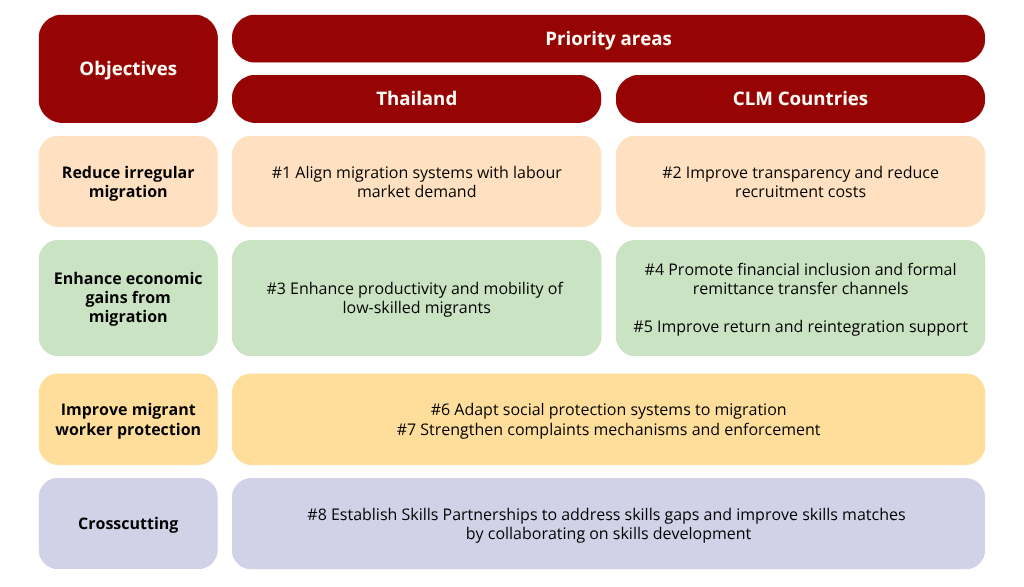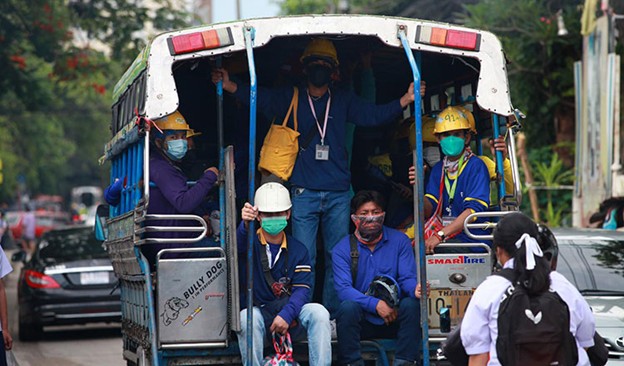Thailand is a strong labour magnet in Southeast Asia, particularly for low-skilled workers from Cambodia, Lao PDR, and Myanmar (CLM). In 2020, an ILO study, carried out by Rapid Aisa, highlighted that nearly three million migrant workers support agriculture, construction, services, and domestic work in Thailand. A follow up study by Rapid Aisa in 2025, published by the World Bank, captured the current picture of the CLM migrant workers in Thailand. So, after five years, are migrant workers on a positive trajectory?
Reflecting on both reports of 2020 “Recruitment Fees and Related Costs” and 2025 “Narrowing Skills Gaps”, there are three important focus areas to understand the migrant worker dynamics in Thailand. They include governance and recruitment practices, skills development and job matching, and labour mobility and integration. Tables A-C below summarise the progress of each focus areas.
Table A. Dynamics of governance and recruitment practices of migrant workers

Table B. Dynamics of skill development and matching

Table C. Dynamics of labour mobility and integration

The tables show that CLM migrant workers’ recruitment systems have become more transparent and regulated in 2025, which is essential for reducing exploitation risks. Results also indicated that skills development programmes are more targeted and responsive to labour market needs and improving job matching. Moreover, safer and more inclusive migration pathways (especially for women and low-skilled workers) are emerging.
As the result five years after the 2020 Report highlight that there has been progress in relation to the dynamics of CLM workers in Thailand. Today, CLM migrant workers’ contribution to the Thai economy is more visible. Due to Thailand’s aging population and shrinking low-skilled labour force, migrant workers contribute 7.5 percent of Thailand’s workforce, filling the gaps in several key sectors, including construction, agriculture, and manufacturing. It is therefore positive that they experience better labour protection and stronger compliance with the minimum wage law in Thailand. Meanwhile, The Social Security Fund (SSF) now reaches over half of all regular migrants, a significant increase from 2020.
Some other metrics also show encouraging results. In terms of recruitment, there has been a reduction from $700–$1,500 average recruitment fees paid by CLM migrants (2020 report) to $300–$600 (2025 report) due to optimization of formal channels. The workers using informal brokers have dropped to 35% in 2025, compared to 60% recorded in 2020.
In terms of skills, the 2025 report shows that 55% CLM migrants have been trained via TVET and pre-departure programs, compared to less than 20% in 2020. Targeted training has contributed to a reduction of employers reporting skill mismatch, from 70% (2020) to 40% (2025).
It is important to note that female migrant participation has increased from 35 up to 44% of the total migrant workforce in 2025.
Actions Needed
The 2025 report highlights that labour mobility remains Thailand and CLMs’ jobs agenda through recruitment systems overhaul, formal channels expansion, and labour protection enforcement, as summarised in Table D below.
Table D: Priority areas to Enhance Net Gains from Labor Mobility

The CLM migrant workers in Thailand are on a positive trajectory to become a more recognized part of the Thai workforce. Their skill gaps have been narrowed moderately but meaningfully. It is due to targeted training, better employer coordination, and improved migration governance. There has been an overall shift from reactive to proactive systems in both Thailand and CLM countries. However, challenges remain in narrowing critical gaps. Informal recruitment persists, and many migrants still work below their skill level. Hence, sustained investment in training, certification, and regional cooperation remains essential.
To read the reports, please follow the links:
- “Narrowing Skills Gaps= Labor Mobility from Cambodia, Lao PDR, Myanmar to Thailand” (2025 Report)
- “Recruitment fees and related costs: What migrant workers from Cambodia, the Lao People’s Democratic Republic, and Myanmar pay to work in Thailand” (2020 Report)
Rapid Asia is highly committed to support sustainable and responsible business practices to make differences to our society. If you found this article useful, please remember to ‘Like’ and share on social media, and hit the ‘Follow’ button never to miss an article. The full 2025 report can be found here.
About the authors: Daniel Lindgren is the Founder of Rapid Asia Co., Ltd., a management consultancy firm based in Bangkok that specialises in evaluations for programs, projects, social marketing campaigns, and other social development initiatives. Israr Ardiansyah is a freelance writer working with Rapid Asia.

